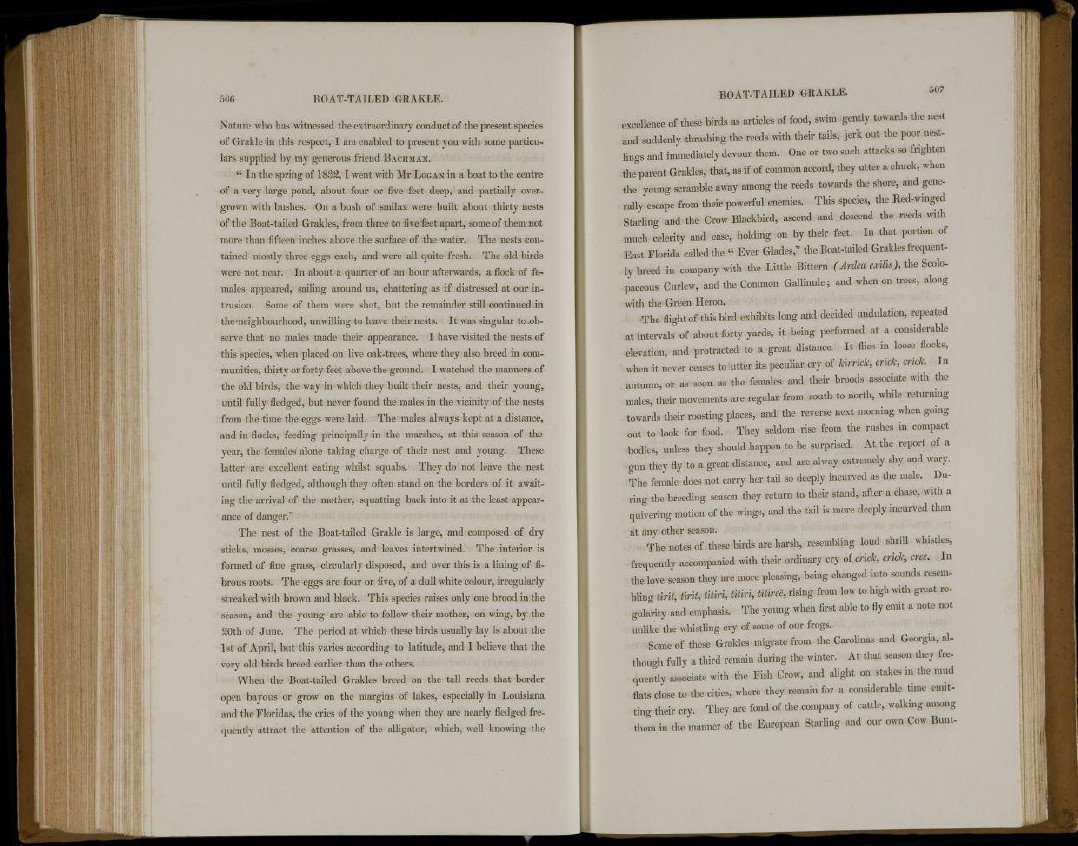
Nature who has witnessed the extraordinary conduct of the present species
of Grakle in this respect, I am enabled to present you with some particulars
supplied by my generous friend BACHMAN.
" In the spring of 1832,1 went with Mr LOGAN in a boat to the centre
of a very large pond, about four or five feet deep, and partially overgrown
with bushes. On a bush of smilax were built about thirty nests
of the Boat-tailed Grakles, from three to five feet apart, some of them not
more than fifteen inches above the surface of the water. The nests contained
mostly three eggs each, and were all quite fresh. The old birds
were not near. In about a quarter of an hour afterwards, a flock of females
appeared, sailing around us, chattering as if distressed at our intrusion.
Some of them were shot, but the remainder still continued in
the'neighbourhood, unwilling to leave their nests. It was singular to observe
that no males made their appearance. I have visited the nests of
this species, when placed on live oak-trees, where they also breed in communities,
thirty or forty feet above the ground. I watched the manners of
the old birds, the way in which they built their nests, and their young,
until fully fledged, but never found the males in the vicinity of the nests
from the time the eggs were laid. The males always kept at a distance,
and in flocks, feeding principally in the marshes, at this season of the
year, the females alone taking charge of their nest and young. These
latter are excellent eating whilst squabs. They do not leave the nest
until fully fledged, although they often stand on the borders of it awaiting
the arrival of the mother, squatting back into it at the least appearance
of danger."
The nest of the Boat-tailed Grakle is large, and composed of dry
sticks, mosses, coarse grasses, and leaves intertwined. The interior is
formed of fine grass, circularly disposed, and over this is a lining of fibrous
roots. The eggs are four or five, of a dull white colour, irregularly
streaked with brown and black. This species raises only one brood in the
season, and the young are able to follow their mother, on wing, by the
20th of June. The period at which these birds usually lay is about the
1 st of April, but this varies according to latitude, and I believe that the
very old birds breed earlier than the others.
When the Boat-tailed Grakles breed on the tall reeds that border
open bayous or grow on the margins of lakes, especially in Louisiana
and the Floridas, the cries of the young when they are nearly fledged frequently
attract the attention of the alligator, which, well knowing the
excellence of these birds as articles of food, swim gently towards the nest
and suddenly thrashing the reeds with their tails, jerk out the poor nestlings
and immediately devour them. One or two such attacks so frighten
the parent Grakles, that, as if of common accord, they utter a chuck, when
the young scramble away among the reeds towards the shore, and generally
escape from their powerful enemies. This species, the Red-winged
Starling and the Crow Blackbird, ascend and descend the reeds with
much celerity and ease, holding on by their feet. In that portion of
East Florida called the " Ever Glades," the Boat-tailed Grakles frequently
breed in company with the Little Bittern (Ardea exilis), the Scolopaceous
Curlew, and the Common Gallinule; and when on trees, along
with the Green Heron.
•The flight of this bird exhibits long and decided undulation, repeated
at intervals of about forty yards, it being performed at a considerable
elevation, and protracted to a great distance. It flies in loose flocks,
when it never ceases to utter its peculiar cry of kirrick, crick, crick. In
autumn, or as soon as the females and their broods associate with the
males, their movements are regular from south to north, while returning
towards their roosting places, and the reverse next morning when going
out to look for food. They seldom rise from the rushes in compact
bodies, unless they should happen to be surprised. At the report of a
gun they fly to a great distance, and are alway extremely shy and wary.
The female does not carry her tail so deeply incurved as the male. During
the breeding season they return to their stand, after a chase, with a
quivering motion of the wings, and the tail is more deeply incurved than
at any other season.
The notes of these birds are harsh, resembling loud shrill whistles,
frequently accompanied with their ordinary cry of crick, crick, cree. In
the love season they are more pleasing, being changed into sounds resembling
tirit, tirit, titiri, titiri, titircc, rising from low to high with great regularity
and emphasis. The young when first able to fly emit a note not
unlike the whistling cry of some of our frogs.
Some of these Grakles migrate from the Carolinas and Georgia, although
fully a third remain during the winter. At that season they frequently
associate with the Fish Crow, and alight on stakes in the mud
flats close to the cities, where they remain for a considerable time emitting
their cry. They are fond of the company of cattle, walking among
them in the manner of the European Starling and our own Cow Bunt